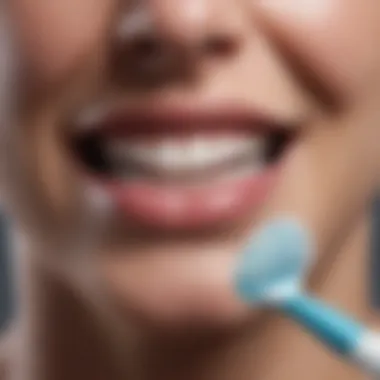Understanding Black Stains on Teeth: Causes & Solutions


Intro
The presence of black deposits on teeth can evoke a range of emotions, from concern to confusion. Many individuals may wonder about the origins and implications of these dark stains. This article aims to shed light on this dental phenomenon, delving into the various factors that contribute to the appearance of black substances on teeth. Understanding these factors is critical for maintaining optimal oral health and preventing further complications.
To begin, it is important to recognize that the black stuff on teeth can stem from multiple sources, including dietary choices, oral hygiene practices, and underlying medical conditions. Each of these components plays a significant role in the formation of such deposits. By the end of this exploration, readers will have gained a comprehensive understanding of not only the causes but also the necessary measures for prevention and treatment.
As we navigate through this topic, we aim to provide valuable insights for students, researchers, educators, and professionals alike. This information is essential for anyone interested in enhancing their knowledge of dental health and addressing the issues related to black deposits on teeth.
Overview of Research Topic
Brief Background and Context
The exploration of dental health issues surrounding black deposits has gained attention in recent years. Black stains can not only affect aesthetics but also indicate potential underlying health issues. Understanding the reasons behind these deposits is crucial as it leads to better oral hygiene practices and awareness of overall health.
Much of the current research focuses on understanding the biochemical nature of these deposits, their correlation with various health conditions, and their impact on dental care protocols.
Importance in Current Scientific Landscape
The presence of black deposits on teeth signifies more than mere cosmetic concerns. Scientifically, it sheds light on the complexities of oral microbiomes and their interactions with dietary choices, oral care products, and systemic health conditions. This makes the study of this issue significant not just in dentistry, but in holistic health disciplines as well.
Prelims to Dental Stains
Dental stains play a significant role in overall oral health. They often serve as indicators of underlying issues, revealing insights about hygiene practices and diet. Understanding dental stains is crucial for both prevention and treatment. This section provides clarity on what dental stains are, why they occur, and how they can impact one’s health.
Knowing the types of dental stains helps in addressing them properly. Different types require distinct approaches for prevention and remediation. This section goes beyond basic definitions, offering a nuanced understanding that benefits educators, researchers, and dental health professionals alike.
Defining Dental Stains
Dental stains refer to the discolorations that appear on the surface of teeth. These variations in color can arise due to a multitude of factors ranging from dietary choices to lifestyle habits. Stains can be superficial or embedded within the tooth structure.
Common Characteristics:
- Appearance can vary from yellow to brown and, in some cases, black.
- They may affect both aesthetic and functional aspects of dental health.
Being aware of the definition of dental stains is the first step toward understanding their implications.
Types of Dental Stains
Different types of dental stains can be categorized based on their origin and composition. Understanding these types allows for targeted treatment strategies.
Extrinsic Stains
Extrinsic stains occur on the surface of the enamel. They often result from exposure to certain foods, beverages, and tobacco products. Coffee, tea, red wine, and dark sodas are typical culprits. A key characteristic of extrinsic stains is their removal through professional cleaning and proper oral hygiene.
Benefits of Understanding Extrinsic Stains:
- They are usually preventable by modifying one's diet.
- Regular cleaning can effectively manage these stains, improving overall aesthetics quickly.
Additionally, understanding the nature of extrinsic stains highlights the importance of routine dental check-ups and maintenance in comprehensive oral care.
Intrinsic Stains
In contrast, intrinsic stains form within the tooth structure. They generally arise from factors such as trauma, certain medications, or excessive fluoride exposure during childhood. The key feature of intrinsic stains is their resistance to conventional whitening methods.
Understanding Intrinsic Stains:
- These stains can signify deeper health issues at play, making them vital for attention.
- Their complex nature requires specialized treatment, often needing professional intervention.


Recognizing intrinsic stains is critical to diagnosing potential underlying problems effectively.
Composite Stains
Composite stains refer to discolorations that affect dental restorations, such as fillings or crowns. They may be caused by staining agents present in food and drinks. The distinctive feature of composite stains is that they can present challenges in restoring the original appearance of dental work.
Characteristics of Composite Stains:
- They can require replacement of the restoration for effective removal.
- Awareness of these stains helps in choosing appropriate materials for dental work.
Understanding composite stains is essential for dental professionals ensuring long-term patient satisfaction and effective treatment outcomes.
The Nature of Black Deposits
Understanding the nature of black deposits on teeth is crucial for both dental professionals and individuals concerned about oral health. These deposits are often indicative of underlying issues such as poor hygiene or dietary choices. Recognizing the characteristics of these black substances can aid in timely intervention and treatment. It's essential to properly identify these deposits as they could range from harmless stains to more serious conditions requiring dental attention.
Identification of Black Matter
Identifying the black matter on teeth involves examining its texture, appearance, and location. Each of these elements serves as an important diagnostic component in understanding the presence of black deposits.
Texture and Appearance
The texture and appearance of black deposits can vary significantly. Typically, these deposits may feel gritty or rough to the touch. They can often be darkly pigmented and may range from a faded black hue to a deep, jet-black color. The distinct texture suggests a buildup of hardened plaque or tartar that has been subjected to pigmentation from various external factors.
A key characteristic of texture is its ability to attract more bacteria. This can result in a continuing cycle of buildup if not managed properly. The unique feature is the smooth or glossy layer over older deposits, making them more challenging to remove. This can lead to further complications, reinforcing the need for regular dental check-ups to monitor and manage any such issues.
Location on Teeth
The location of black deposits on teeth plays a vital role in their identification. Common areas include the crevices between the teeth, along the gum line, and on the outer surfaces of molars where food particles tend to accumulate. This key characteristic underscores where one might typically observe such deposits. Each specific location provides insights about an individual's dental hygiene practices.
The unique feature of these locations is that areas more prone to food retention also see higher chances of staining. This fact leads to greater susceptibility to cavities if left untreated. Thus, identifying these sites enables better dental hygiene strategies and early detection of potential diseases.
Common Misconceptions
There are several misconceptions surrounding black deposits on teeth. One common belief is that they are solely a cosmetic issue, neglecting the health risks they pose. Another is that only older individuals experience these deposits; however, they can affect anyone regardless of age or lifestyle. Addressing these misconceptions is vital. Awareness leads to better preventive measures and can promote healthier outcomes.
"Understanding the nature of black deposits provides crucial insights into preventing further dental complications."
In summary, recognizing the nature of black deposits informs both the individual and dental professionals about necessary steps to maintain oral hygiene. Each characteristic aids in diagnosing underlying problems, fostering better health outcomes.
Causes of Black Deposits
Understanding the causes of black deposits on teeth is vital for maintaining good oral health. These deposits can indicate underlying issues that need to be addressed. Grasping the reason behind their occurrence can aid in determining appropriate preventive measures and treatment options. This section will explore various causes, helping readers connect the dots between their lifestyle choices and the state of their dental health.
Bacterial Accumulation
Plaque Formation
Plaque formation is one of the primary contributors to black deposits on teeth. This sticky film is made up of bacteria, food particles, and saliva. If not removed regularly through brushing, plaque can harden into tartar. The key characteristic of plaque is that it is often colorless, making it harder to detect. However, its progression can lead to discoloration, including black stains.
The formation of plaque is a significant topic here. If plaque builds up, it promotes further bacterial growth, leading to potential gum disease and cavities. One unique feature of plaque is its ability to thrive in areas that are difficult to clean, such as between teeth and along the gum line. This can be detrimental as it can lead to chronic oral health problems if not addressed promptly.
Role of Oral Hygiene
The role of oral hygiene in preventing black deposits cannot be overstated. Effective brushing and flossing remove food debris and plaque. A fundamental aspect of proper oral hygiene is consistency. Brushing at least twice daily and flossing regularly can drastically reduce the risk of buildup.
Maintaining good oral hygiene is a critical choice for anyone looking to improve their dental health. One unique feature is the use of fluoride toothpaste, which strengthens enamel and protects against decay. However, neglecting these practices can lead to serious oral health issues, including tooth decay and gum disease.


Dietary Factors
Food and Beverage Choices
The choices we make in our diet impact our oral health directly. Certain foods and beverages can promote staining and contribute to black deposits. For instance, acidic foods and drinks can erode enamel, making teeth more susceptible to staining.
Food and beverage choices hold significant weight in the context of this article. The inherent nature of some substances, such as coffee and red wine, can cause discoloration. One unique aspect is that while these items can be enjoyed, moderation is key to minimizing their negative impact on teeth. Regular consumption could lead to more pronounced black deposits, which can be difficult to remove.
Impact of Staining Agents
Staining agents are substances that can result in visible discoloration on teeth. These agents can result from dietary habits, such as smoking, or consuming certain foods. The extent of their impact varies among individuals based on their oral care routines.
Staining agents significantly affect the discussion of black deposits. A notable feature of these agents is their ability to compound over time, gradually impacting tooth aesthetics. If individuals are aware of these substances, they can take proactive steps to limit exposure and maintain a brighter smile. This understanding could lead to effective oral health strategies.
Intrinsic Factors
Genetics
Genetics can play a role in an individual’s susceptibility to black deposits. Some individuals may have a genetic predisposition that influences the structure and coloration of their teeth. This aspect is often overlooked but offers valuable insights into certain patterns of staining.
Genetics becomes relevant when analyzing why some people develop black deposits more readily than others. A unique feature of this factor is that it can combine with others, such as diet and oral hygiene, to create a multifaceted impact. Understanding one's genetic predisposition can lead to personalized care approaches.
Medical Conditions
Certain medical conditions can cause discoloration and black deposits on teeth. For example, conditions like iron deficiency or certain autoimmune diseases can affect the health and color of teeth. This link emphasizes the relationship between systemic health and oral hygiene.
Medical conditions provide significant insight into the origins of black deposits. A key characteristic is how these conditions may lead to changes in saliva production, affecting the oral environment. Individuals dealing with underlying medical issues must be aware of their potential effects on dental health to tackle problems early.
This understanding will empower you to make informed decisions for your oral health, leading to a brighter smile and fewer complications.
Health Implications of Black Deposits
Understanding the health implications of black deposits on teeth is essential for maintaining overall oral hygiene. Black deposits can signify more than just aesthetic concerns; they often indicate deeper underlying health issues. Recognizing these implications can help individuals take proactive measures, thereby improving their dental and general health. This section will discuss various health effects associated with these black stains on teeth, including the risk of decay, gum problems, and even broader systemic health concerns.
Decay and Cavities
Black deposits can facilitate the development of dental decay and cavities. These stains often indicate the presence of plaque, a sticky film of bacteria that forms on teeth. When plaque accumulates, it produces acids that can erode tooth enamel, leading to cavities. It is crucial to address the root cause of these black deposits before they result in irreversible damage.
Neglecting dental hygiene amplifies the risk of decay. Regular brushing and flossing disrupt plaque formation, while over time, allowing black deposits to linger can worsen decay severity. The significance of maintaining a regular dental routine cannot be overstated, as early interventions can lead to better outcomes and fewer dental procedures down the line.
Gum Problems
Gingivitis
Gingivitis is a common condition arising from the buildup of plaque, which is often visible as black deposits on teeth. It is characterized by inflammation of the gums, leading to redness, swelling, and a tendency to bleed during brushing. Treating gingivitis effectively is crucial, as it can easily progress to more severe gum diseases if left unaddressed.
The key characteristic of gingivitis is that it is reversible with proper oral hygiene. Maintaining healthy gums reduces systemic inflammation and may contribute to better overall health. Gingivitis exemplifies how black deposits can be more than just cosmetic issues; they can directly affect gum health and, ultimately, overall well-being.
Key Feature: Early detection and treatment are critical in managing gingivitis.
Periodontal Disease
Periodontal disease is a serious progression of gingivitis. It leads to the destruction of the supporting structures of the teeth, including the bone. The unique feature of periodontal disease is its potential to contribute to tooth loss if not managed. Individuals with periodontal conditions often experience chronic infections that weaken the immune system and create systemic health risks.
The benefit of discussing periodontal disease here lies in its association with other health issues; untreated gum disease can lead to complications beyond oral health. It represents a significant risk not only for the teeth but also for overall health.
Systemic Health Effects


Connections to Heart Health
The link between oral health and heart health is increasingly recognized in medical research. Poor oral hygiene and the presence of gum disease contribute to inflammation in the body and can lead to cardiovascular issues. Bacteria from gum infections may enter the bloodstream, harming heart tissue and potentially leading to heart disease. Therefore, understanding how black deposits can indicate gum disease is crucial for those concerned with heart health.
Noteworthy Aspect: Regular dental visits and proper hygiene can serve as preventive measures against systemic health issues related to the heart.
Links to Diabetes
There exists a two-way relationship between gum disease and diabetes. Individuals with diabetes have a higher susceptibility to infections, making them more likely to develop periodontal conditions. Conversely, severe gum disease can affect blood sugar control, complicating diabetes management.
Recognizing these links underlines the importance of maintaining oral health, especially for those at risk for diabetes. Better oral hygiene can contribute positively to managing blood glucose levels. Therefore, the connection between black deposits and diabetes highlights the systemic implications of oral health that extend beyond the mouth.
"Oral health is an integral part of a person’s overall health."
Preventive Measures for Oral Health
Preventive measures are vital in maintaining good oral health and preventing the occurrence of black deposits on teeth. These measures encompass a variety of practices that aim to reduce the risk of dental stains, plaque accumulation, and related oral diseases. Understanding how to effectively engage in preventive practices can significantly enhance one’s overall dental condition.
Effective Oral Hygiene Practices
Brushing Techniques
Brushing the teeth properly is essential for good oral hygiene. Effective brushing techniques include using a soft-bristled toothbrush and fluoride toothpaste. These elements work together to remove plaque while protecting enamel. A notable characteristic of effective brushing is the method; circular motions or gentle back-and-forth strokes are preferred. This approach is beneficial in that it helps to effectively clean all surfaces of the teeth. Additionally, brushing twice a day is a common recommendation that underscores its importance in daily routines. However, many people do not brush long enough to achieve the desired results, which can limit its effectiveness.
Flossing Importance
Flossing should not be overlooked in oral health regimens. It is crucial for removing food particles and plaque from between the teeth and along the gum line. A significant characteristic of flossing is its ability to reach areas that a toothbrush cannot, which contributes to the prevention of cavities and gum issues. Many dental professionals highly recommend daily flossing as a compliment to brushing. The unique feature of flossing is its preventive nature; by maintaining clean inter-dental spaces, one can avoid the buildup that leads to stains and decay. Nevertheless, some may find it challenging or inconvenient, which could impact its regular use.
Dietary Adjustments
Reducing Sugary Foods
Diet plays a significant role in oral health, particularly regarding the prevention of black deposits. Reducing sugary foods can greatly lower the risk of tooth decay as sugary snacks often contribute to the formation of plaque, which leads to stains. A key characteristic of this dietary change is its simplicity; replacing sweets with healthier alternatives is relatively easy. This adjustment is beneficial because it not only protects teeth from discoloration but also supports overall health. However, it may require a conscious effort to choose alternatives in a culture that often celebrates sugar-rich foods.
Hydration and Impact
Staying hydrated has profound implications for oral health. Proper hydration helps maintain saliva levels, which plays a crucial role in washing away food particles and neutralizing acids produced by bacteria. This characteristic of hydration makes it a beneficial practice in fighting both stains and cavities. Additionally, drinking water regularly can prevent dry mouth, a condition that may contribute to plaque buildup. One unique feature of good hydration is that it can be a low-maintenance habit that integrates easily into daily routines. In contrast, individuals may often forget to drink enough water, diminishing its preventive benefits.
Regular Dental Check-Ups
Importance of Professional Cleaning
Professional dental cleanings are essential in preventing the buildup of black deposits. During these visits, dentists can remove tartar that toothbrushes cannot effectively handle. A key characteristic is the thoroughness of these cleanings, which ensures that all areas, including those that are often neglected, are addressed. This practice is highly beneficial as it contributes to maintaining long-term oral health. One downside is the cost associated with regular check-ups, which may deter some individuals from visiting the dentist as frequently as advised.
Early Detection of Issues
Regular dental visits also allow for the early detection of potential issues. Dentists can identify black deposits before they become severe, which is significant in preventing more serious health problems. The key characteristic here is that early intervention can save time and money in the long run. Furthermore, catching issues early can enhance treatment outcomes. However, some patients may fear dental visits, which could result in avoiding necessary care.
Preventive measures are not just beneficial; they are fundamental in the fight against black deposits and promote long-lasting oral health.
In summary, engaging in effective oral hygiene practices, making appropriate dietary adjustments, and prioritizing regular dental check-ups are essential strategies in maintaining oral health. By understanding and implementing these preventive measures, individuals can significantly reduce the risk of black deposits and associated complications, leading to healthier teeth and gums.
Closure
In this article, we explored the significance of understanding black deposits on teeth. Key elements include identifying causes, implications for oral health, and preventive strategies. It is critical for individuals to recognize that these deposits are often more than a cosmetic concern. They may indicate underlying health issues or poor oral hygiene practices. Therefore, addressing them proactively can prevent more severe dental problems.
Summarizing Key Points
- Identification: Recognizing black deposits and their forms is the first step in managing oral health.
- Health Risks: Black deposits can lead to gum diseases and systemic health issues, highlighting their potentials beyond mere appearance.
- Preventive Measures: Adopting effective oral hygiene practices can significantly reduce the occurrence of these deposits. Regular dental visits are also essential for maintenance.
The Importance of Awareness
Awareness of the implications of black stains on teeth is crucial for maintaining overall health. Understanding that these stains can signal bacterial accumulation or nutritional deficiencies empowers individuals to take action. Increased knowledge leads to better preventive habits, thus safeguarding not only dental health but overall well-being.
"Knowledge is the first step towards change. Recognizing dental health as an integral part of one’s overall health cannot be overstated."



